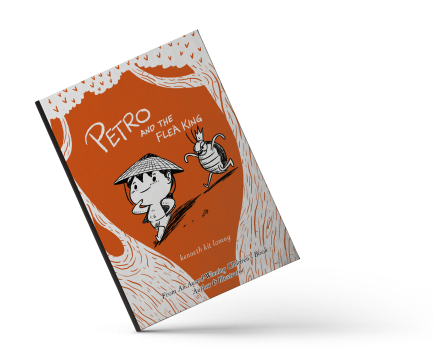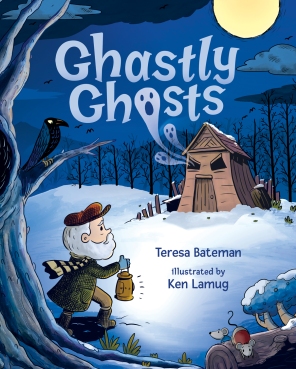 Ken is not only a talented artist and writer, but he’s also incredibly giving of his time and expertise to his fellow kidlit creators, and serves as the regional illustrator coordinator for his SCBWI chapter. I’m honored Ken took time out to share his experience with graphic novel creation and to give us a sneak peek at his upcoming collaboration with author Teresa Bateman. Double bonus, one lucky reader will receive a signed copy of Petro and the Flea King!
Ken is not only a talented artist and writer, but he’s also incredibly giving of his time and expertise to his fellow kidlit creators, and serves as the regional illustrator coordinator for his SCBWI chapter. I’m honored Ken took time out to share his experience with graphic novel creation and to give us a sneak peek at his upcoming collaboration with author Teresa Bateman. Double bonus, one lucky reader will receive a signed copy of Petro and the Flea King!
Thank you, Ken!
You self-published your wordless graphic novel Petro and the Flea King, which my family owns and LOVES. Why did you choose that route? And what were the challenges of a wordless graphic novel?
When I started my publishing journey, I did it because of my love for storytelling and illustrating.
 I realized early on that the traditional publishing route is a long journey and that there is a high possibility that many of my ideas will not make it to the bookshelves. So I told myself that I would have a plan B which is self-publishing. It just so happened that Createspace/Amazon offered such a service that fit Petro and the Flea King perfectly.
I realized early on that the traditional publishing route is a long journey and that there is a high possibility that many of my ideas will not make it to the bookshelves. So I told myself that I would have a plan B which is self-publishing. It just so happened that Createspace/Amazon offered such a service that fit Petro and the Flea King perfectly.
I knew that a wordless graphic novel would be a challenge to sell, but at that point it didn’t matter. The train had left the station, and it was a book that I wanted to create.
One of the technical challenges was a personal test to see if I could complete a book with 100+ pages of illustrations and to see how long it would take. And being that it was a wordless, I had to create more illustrations to show small emotions and reactions that could be easily conveyed by speech or word bubble.
I showed the book to graphic novel publishers, and even traditional publishers, and while they loved the illustrations and ideas, they also had to look at the market dynamics to see if it was something they could sell. And this is probably the biggest challenge.
You also funded your The Tall Tales of Talbot Toluca series through Kickstarter, so you’ve already got this amazing entrepreneurial spirit. What pushed you into traditional publishing finally?
Yes, I love challenges! When someone says I can’t do something … I take those fightin’ words and use them as motivation.
One thing most traditional picture book people don’t realize right away, is that the comic book industry is filled with entrepreneurs. A lot of popular graphic novels and comic books today started off as self-published works, gracing the comic book convention floors. They had enough fan following that publishers decided to acquire the books.
The Tall Tales of Talbot Toluca started off as puzzle-comic-book hybrid, and through the help from Kickstarter, I was able to turn the book into a reality.
I knew early on that certain books I created were not for traditional publishing so it was an easy decision to take those books via the self-publishing route.
And at the time I was still early enough in my publishing journey that I looked at things as part of the learning process. So there is always something to be gained by trying a new and different approach.
You’ve got an upcoming picture book release, Ghastly Ghosts, written by author Teresa Bateman. How did all that come about?
 Ghastly Ghosts is one of those books that I was signed onto because Albert Whitman (the Publishers) saw Petro, along with my other books. They specifically liked my ink and line work from that book and wanted to use a similar style in Ghastly Ghosts.
Ghastly Ghosts is one of those books that I was signed onto because Albert Whitman (the Publishers) saw Petro, along with my other books. They specifically liked my ink and line work from that book and wanted to use a similar style in Ghastly Ghosts.
Early in my career I also worked on Edward Gorey styled books using heavy inking and cross hatching. This included Hurts Like a Mother, The Stumps of Flattop Hill, A is for Asteroids, Z is for Zombies. So, Albert Whitman knew that I enjoyed working on spooky themed stories.
My flavor of artwork and style fit perfectly for Ghastly Ghosts.
I really love the artwork for Ghastly Ghosts, but I can definitely see the comics-style influence in the art. What is it about comics and graphic novels that excites you as an artist and author?
Thank you. For this project being a children’s picture book I actually wanted more traditional-looking art with less inking lines commonly associated with comic book style. But the publisher preferred to go this direction which gave me confidence that they really liked my style.
I’m very flexible as an artist and I actually would like to work on a project that doesn’t look very comic booky. And for Ghastly Ghosts, I tried to soften the lines by giving them color rather than just black. You’ll see this when you get the book.
How did you get into the graphic novel market?
I’m working on my first traditionally published graphic novel, and until that’s published, I wouldn’t dare consider myself in this market yet.
My upcoming graphic novel Mischief and Mayhem started as a 32-page picture book story.
 During the submission process we were getting a few interested parties, but they wanted to see it expanded into a graphic novel. So I started working on a chapter breakdown and creating a fully illustrated chapter to show the publishers what it would look like.
During the submission process we were getting a few interested parties, but they wanted to see it expanded into a graphic novel. So I started working on a chapter breakdown and creating a fully illustrated chapter to show the publishers what it would look like.
After several rounds of review, Mischief and Mayhem was acquired by Mabel Hsu at HarperCollins/Tegen.
You really helped me out when I was looking into how to prepare a graphic novel manuscript. You sent me the template for Scrivener (the new version of Scrivener now has two graphic novel templates now!), and guided me through the process of formatting my text. Can you talk about that a bit for everyone else?
I’m glad it helped you out. It’s a very useful tool for writing in general. But you can write a graphic novel in word or even notepad if you know the format. I’ve known comic book writers who do everything in a yellow notepad!
Scrivener does help keep things organized and when you’re writing a 200+ page book, or something that you have to share with an editor or artist, having structure becomes very important.
So when writing a GN, write it similar to a stage play or a movie script.
The book has to be broken down into chapters, and chapters into pages, and pages into panels. For those who are unfamiliar, a panel is the box where all the action happens and on every page there can be 1-6 or even more panels. (Typically 6 panels is a good number for middle-grade GNs.)
Whenever I write a script, I write it for someone who can’t see the pictures. So I have to describe exactly what is going on. Here’s an example:
PAGE 100
Panel 1 – Ext. Night Raining
Mischief and Mayhem are outside at night wearing their super villain outfit. Mischief is the lead villain and Mayhem is her side-cat.
MAYHEM
Ugh. Why are we here again? I hate getting wet.
MISCHIEF
Sorry! I didn’t know. We have a job to do.
Panel 2
MAYHEM
We could be home, drinking hot cocoa with floaty marshmallows.
MISCHIEF
Don’t chicken out on me. I’m drenched too.
Panel 3
MAYHEM
You should’ve checked the weather. Don’t you have an umbrella in your
utility belt?MISCHIEF
You can’t trust weather people. They’re always lying.
Panel 4 – Ext. Night Raining
From out of nowhere, CLOUD BOY appears, a superhero. He hovers above the villains. It looks like he’s controlling the rain.
CLOUD BOY
Ha! Ha! Ha! Cold enough for ya?
MAYHEM
Look! It’s Cloud Boy! He’s doing this!
Panel 5
Mayhem and Mischief goes into fighting pose.
MISCHIEF
Aha! I knew there was a puff of hot air blowing this way.
MAYHEM
You’ll pay for my frizzy hair. Hi-yah!
In this example, I write the page number and break down the number of panels for each page and the dialog and events happening within each panel.
If you’re writing this for someone else to illustrate, the more detailed, the better. If you’re doing the illustrations yourself, then you might get away with very few descriptions.
A great tutorial you can reference is by Antony Johnston, he worked with Scrivener to create the graphic novel template used in the application.
You can find his site at http://antonyjohnston.com/forwriters/scriveningcomics.php
What programs do you use to create your graphic novels?
For scripting/writing I use Scrivener and there is also a free web version called celtx.com
And for drawing/inking and coloring I use a combination of Clip Studio Pro & Photoshop.
How do you plan out your graphic novel stories? Art or words first?
Words always come first. Especially when you’re working with an editor, all the words should be approved even before you start drawing.
I found out that the steps below work best. I start off from a basic idea of the story then drill down into smaller details.
Step 1: # of pages. Find out the number of pages for your book. Sometimes the publishers will give you a specific page count (often 200-300 pages).
Step 2: Write the story idea from beginning to end. This can be a few paragraphs or sometimes a list of sequence of events you want to happen.
Step 3: Expand the list, separate them into chapters and write more story details on each chapter. How can you build the characters, plot in every chapter and add a cliff hanger at the end?
Step 4: Write an estimate number of pages for each chapter keeping in mind your target # of pages.
Step 5: Using the guide you’ve created, start writing a page-by-page script. Don’t worry too much if you go beyond your page count as it’s always easy to make things tighter.
What tricks have you learned to make it easier to create them?
Tip #1: Sometimes you might not have enough of a story to fill 240+ pages. Remember that graphic novels and stories in general are all about small moments and meaningful details. So put a magnifying glass on your characters and highlight those moments that make them unique.
Tip #2: Don’t be afraid to use references or borrow ideas from other artists. EVERYONE does it and it will only help your technique in the long run.
Tip #3: You don’t have to jump into the ocean right away. If a 200+ page GN scares you, break it down into smaller stories. A lot of graphic novels these days are actually comic book compilations. They create a 24-page comic book and compile them into one big book and release those as “trade-paperback.” So start off small and learn the ropes.
How do you plan out your dialogue tags?
The dialogue tags or word bubbles can affect the layout of the page and how big your panels are. So I will usually keep in mind how much text goes into a particular panel before I draw.
How do you submit a graphic novel text to an agent or publisher?
It was only a few years ago when comic books and graphic novels were looked down upon, but today, most traditional publishers are loving the format.
Getting your graphic novel idea published is now very similar to picture book submissions. If you’re a writer, submit a solid manuscript, and if you’re illustrating as well, include a fully illustrated first chapter.
Often times publishers have a separate imprint dedicated to their graphic novel division. So make sure to do your due diligence and read their requirements before submitting. And in some cases, publishers will hold an open submission for un-agented writer/illustrators to submit their work. So keep your eyes open, since this is a fantastic opportunity to get published.
Would you consider illustrating a graphic novel that you didn’t write? If so, what would you need to see in the manuscript to want to take that massive job on?
I’ve illustrated comic books for other writers, and I would not mind illustrating a graphic novel for someone else. For me, it’s all about getting the right project that I can connect with, making sure that my skills and style work well with the story and that the timing works out.
Graphic novels take a large amount of time, and I have to make sure that I stay healthy and meet my other commitments as well.
What’s on the horizon for you?
My next two years will be dedicated to Mischief & Mayhem. I’m working hard to make it an awesome book that kids and adults will enjoy.
Thank you, Ken!
To win a signed copy of Petro and the Flea King, please comment once below. For an additional entry, share this post on social media and copy the link where you shared it in with your comment. The winner will be announced on Sept. 4.
Update: Janet Johnson is the winner of Petro and the Flea King! Congrats, Janet! The raffle is now closed.
For more information about Ken and his work:








What a great interview. I learned so much about the graphic novel writing process. Also, love your style, Ken!
LikeLiked by 1 person
Thank you!
LikeLike
Thank you for this interview! My son is obsessed with graphic novels right now.
LikeLiked by 1 person
I can understand that. I love graphic novels too. Thanks for commenting.
LikeLike
Janet, you are the winner!
LikeLike
Great interviews! I’m dipping my fingers into the graphic novel genre and this is really helpful. Thanks for sharing Ken. And congrats on your upcoming books.
Twitter: This interview with author/illustrator Ken Lamug on Johnell DeWitt’s blog is really helpful for illustrators interested in the graphic novel genre. Plus his art is awesome. https://johnelldewitt.com/2019/08/27/interview-with-author-illustrator-ken-lamug/
LikeLiked by 1 person
I’m glad it helped, Carolyn!
LikeLike
Incredibly helpful post. Thank you!
LikeLiked by 1 person
Thank you for reading it!
LikeLike
Ken and his work are fantastic! Thanks for this wonderful interview with so much detail on process.
LikeLiked by 1 person
Thank you for commenting.
LikeLike
What BEAUTIFUL work from Ken Lamug. When I see such from a self-published creative, I wish I owned a publishing house, because he would be on my list.
LikeLiked by 1 person
Yep. Thank you for commenting, Mirka.
LikeLike
A lot of good information! I’m bookmarking this post for further study!
I shared this link on Twitter here: https://twitter.com/tcanny/status/1166345487269662721
LikeLike
Thank you, Tim!
LikeLike
What terrific tips and insights from Ken! Thank you!
~ Susan Hughes
LikeLiked by 1 person
Thanks for commenting, Susan.
LikeLike